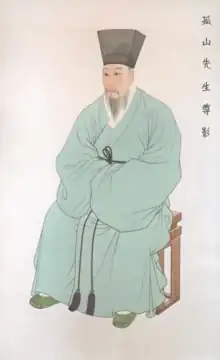Yun Seon-do | |
|---|---|
 | |
| Born | 1587 |
| Died | 1671 |
| Relatives | Yun Du-seo (grand-son) |
| Yun Seon-do | |
| Hangul | 윤선도 |
|---|---|
| Hanja | 尹善道 |
| Revised Romanization | Yun Seon-do |
| McCune–Reischauer | Yun Sŏn-do |
| Art name | |
| Hangul | 고산, 해옹 |
| Hanja | 孤山, 海翁 |
| Revised Romanization | Gosan, Haeong |
| McCune–Reischauer | Kosan, Haeong |
| Courtesy name | |
| Hangul | 약이 |
| Hanja | 約而 |
| Revised Romanization | Yagi |
| McCune–Reischauer | Yagi |
Yun Seondo (Korean: 윤선도; 1587–1671), also spelled as Yoon Sun-Do, was a Korean philosopher, poet, and politician. A Neo-Confucian scholar, he was also known by his art names Gosan and Haeong.[1]
Life
He was born in Seoul, in what is now South Korea. He achieved early success as a government official, but his straightforward character made enemies at court and he was banished for imprudent criticism of those in power. Thirteen years later he returned to become tutor to the royal princes but was later banished again. He spent most of his 85 years in his rustic country home, contemplating the nature of life, teaching and writing poetry.[1][2]
Yun is considered the greatest master of the sijo form in Korean literature.[3] His most famous composition is The Fisherman's Calendar (어부사시사, 1651)[4] a cycle of forty seasonal sijo. In both Chinese and Korean classical poetry, the fisherman symbolized a wise man who lives simply and naturally. In art, the fisherman appeared almost invariably in one of the most common genres of Asian water colors: sets of four paintings, one for each season of the year.
Yun Seondo wove both traditions into The Fisherman's Calendar. It is the longest and most ambitious sijo cycle attempted during the classical period of his life.
Some lines are given below from a translation of the Autumn section by Gross.[5][6]
A fisherman's life is idyllic, away from cares of the world...
Do not mock the old fisherman, you'll see him in every painting.
I look back on the world of men, the farther off the better.[4]
And from Five Friends.[2]
Moon, you watch but keep silent; isn't that what a good friend does?
Works
- Gosan seonsaeng yugo (고산선생유고, 孤山先生遺稿)
- Byeoljip (별집, 別集)
- Yakhwaje (약화제, 藥和劑)
- Cheobangjeonseonchangyak (처방전선창약, 癬瘡藥)
- Hoechungyak (회충약, 蛔蟲藥)
- Haesuyak (해수약, 咳嗽藥)
- Bokhaksinbang (복학신방, 腹학神方)
- Uyeoksinbang (우역신방, 牛疫神方)
- Oseonjubang (오선주방, 五仙酒方)
See also
References
- 1 2 "2016 travel diary 19: The Scholar's Garden #1: Yun Seon-do on Bogildo | London Korean Links". 2016-05-19. Retrieved 2023-07-20.
- 1 2 "Korean Sijo by Yun Sŏndo". thewordshop.tripod.com. Retrieved 2023-07-20.
- ↑ Nahm, Andrew C (1996). Korea: Tradition and Transformation — A History of the Korean People (second ed.). Elizabeth, NJ: Hollym International. p. 121. ISBN 1-56591-070-2.
- 1 2 "어부사시사(漁父四時詞) Fisherman's Calendar". encykorea.aks.ac.kr (in Korean). Retrieved 2023-07-20.
- ↑ Larry Gross: Sijo Masters in Translation – Yun Sŏndo (1996), which has the complete text in translation of Song of Five Friends and Fisherman's Calendar
- ↑ Larry Gross. "The Fisherman's Calendar". thewordshop.tripod.com. Retrieved 2023-07-20.
External links
- The Fisherman's Calendar
- (in Korean) General information about Yun Seondo from Haenam Culture & Tourism
- Brief information about Yun Seondo and sightseeing around Haenam-si from Haenam Culture & Tourism
- (in Korean) Goshan Yun Seondo's memorial museum